
Enough with theory and political food for thought, spring is springing up all around us (except for you poor folks way up north). It is time to leave the books and pencils (remember those?) and go out and do some work. If you procrastinate now by mid-fall you will be cursing yourselves for not starting out earlier. Some of the things we have been experimenting with (other than quinoa
and amaranth as evident throughout our site) is peppers. We eat many
different peppers in many different ways.
Hot peppers need some extra time to grow and produce their best so we start with them earlier. Depending on weather we may start indoors as the seeds need a certain warm temperature to germinate. Then we take the plants out once they pop up and make a temporary greenhouse out of PVC pipe and clear plastic. If you are in a sunny part of the world even if it is cold a small greenhouse sturdy enough to resist wind and just big enough to clear the plants before the temperature will warm up is sufficient. Here we found a good article with the same permaculture tendencies we have, about the tricks of planting chili peppers.
Are you growing chillies or chilis? Nevermind the different spellings, there are even more shapes, sizes and colours!
At one stage growing chillis was a special passion of mine.
Do you know how many different varieties there are? And how ornamental they are?
Just gorgeous!
For a while I had about 25 different chilli varieties growing...
But let's forget about me. Everybody needs to grow chillis for cooking. Even if you don't like hot food, just a little hint of chilli to warm it up stimulates the taste buds and everything else tastes just so much better. True.
And chillies will brighten up your garden!
But before we get to the instructions for growing chillis, lets sort out the spelling, lest you think I don't know any better...
There are three ways to spell the name: chili, chilli and chile.
Yep, some people grow chile. This is the Spanish version of the name, which you also find used in English speaking countries, especially the southwest of America.
The Americans changed chile to chili. Originally chili referred to the dish chili con carne. Then it was shortened to just chili. Chili is the preferred name for the spice made from the fruit of the chile plant. But in America chili is also widely used as the name for the plant and fruit, the chili peppers. They grow chilis over there in the US.
The British are growing chillis. Chilli is also the commonly used spelling in Australia and New Zealand. Permaculture originated in Australia, hence we'll stick to that version if you don't mind.
(As for the plural, both chillis and chillies is accepted.)
Growing Chilli Peppers
What do chilli plants look like?
A bush of Cayenne Peppers
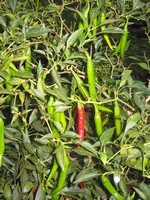 Chilli plants grow into small to medium sized bushes from half a metre to two metres tall. How big they get depends on the species and variety.
Chilli plants grow into small to medium sized bushes from half a metre to two metres tall. How big they get depends on the species and variety.
There are different species of chillies. Most chillies are grown as annuals even though they can live for a few years in warm climates.
Some chilli varieties are true perennials. Most of the common varieties belong to the species capsicum annuum, the "annual" species.
(Bell peppers, called capsicums in Australia, also belong to the species capsicum annuum.)
Chillis have small to medium sized, shiny, dark green leaves. The fruit, the chilli peppers, vary wildly in size and shape.
Chilli peppers are green to start with. Most of them ripen to a rich red, but they can also be orange, yellow, purple or brown.
They may hang down or stand up like little colourful candles. There are even ornamental varieties that are mottled and freckled.
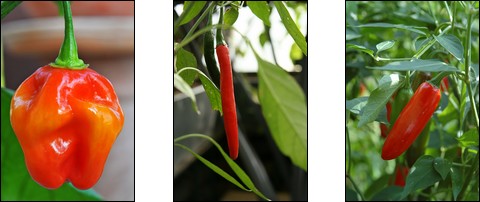 |
| Chili pepper varieties. |
The different chilli types not only vary in size and colour, they also vary in how hot they are! If you grow chillies for the kitchen, choose your variety with care...
Where can you grow chillis?
Chilli plants love heat. They are closely related to capsicums/bell peppers and also related to tomatoes (they are in the same family, the solanaceae), but chillies prefer their growing conditions a lot hotter.
Chilli seeds need 20°C to germinate, and it should be 30°C or more for the fruit to ripen. Night temperatures should not drop below 15°C. (At least not on a regular basis. The odd cool spell is ok.)
Chillies also don't mind humidity as much as sweet peppers or tomatoes do.
Most people will need to grow chillis in full sun. In the hottest, sunniest regions chillies still grow well with a bit of shade. Especially afternoon shade can even be beneficial. (The fruit can get sunburned.)
If you live in the tropics or subtropics, great. Your chillies should thrive. Even the "annual" varieties should live for two to three years and they produce fruit all year round.
If your climate is not tropical, don't despair. You can still grow chillies if you get decent summers. And you can extend the growing season by growing chilis indoors, just like you do with tomatoes.
In fact, chillis are also related to tomatoes, so the growing methods and requirements are similar. Except that chillies need more heat.
People with small gardens or balconies will be pleased to hear that you can grow chillis in pots.
How to grow chillies from seed
You can buy chilli plants in a nursery or you can grow chillis from seed. The seed needs at least 20°C to germinate.
Start them in early spring in cooler climates or any time during the dry season. (You could start them all year round in the tropics, but it's a good idea to let the plants grow strong before the wet season hits them.)
Chilli plants are usually started in seedling trays or small pots. They are very vulnerable when small and they don't grow all that fast.
Still, I prefer to start mine directly in the ground, because like capsicums chillis don't like being transplanted.
Actually, I only start them in the ground when I have enough seed to allow for a high percentage of fatalities. (I am the laziest gardener I know, so I don't look after my seedlings much.) I usually have enough because I save my own seed.
If I buy seed of a new chilli variety and I get one of those tiny packets with barely a dozen seeds in them, then I start them in pots.
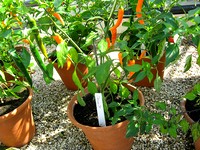 You can plant several chilli seeds per pot. Once your seedlings have a few leaves, snip off the weaker ones and only keep the strongest plants.
You can plant several chilli seeds per pot. Once your seedlings have a few leaves, snip off the weaker ones and only keep the strongest plants.
You only want one chilli plant per pot when you plant them out.
Otherwise you will disturb their roots too much and they HATE having their roots disturbed.
If you grow chillies in seedling trays or little punnets, plant them out once they have four to six true leaves (about 5 cm tall). If you don't, their roots will start feeling restricted and it will set them back.
Chillies don't mind growing in bigger pots, so the timing for planting them out is not critical if you use pots. If you live in a cooler climate, use pots. Let them to grow to 10 to 15 cm. Make sure it's warm enough before you put them outside!
Water the chillies before transplanting, so the soil doesn't fall apart when they're removed from the pot. Be VERY careful when removing the seedlings from their pots.
Drop them in a hole in the garden, fill it back in, firm down the soil, water, done.
Growing chilli plants
Chillies grow in a variety of soils. Like most plants they grow better in rich soils and produce more fruit, but they will grow in any reasonably fertile soil and don't need any special treatment. If you use plenty of mulch and compost in your garden the chillies will grow just fine.
If your soil is poor, you'll have to fertilize your chillies. (And start using more mulch and compost...)
When fertilizing chillies keep in mind that, like their relatives and indeed most fruiting plants, chillies like potassium. Too much nitrogen will make them grow lots of soft leaves and no fruit.
It is important to keep your chilli plants well watered and mulched. Mulch not only improves soil over time, it also protects it from drying out.
Chillies have such a tough and hardy image, people often don't realize how sensitive they are when it comes to lack of water. Make sure your chillies have plenty and never dry out.
At the same time, don't overwater. The soil should be free draining. Chillies don't grow in swamps.
Problems when growing chillies
Chillies have weak branches. If they are loaded with fruit they can snap off. The whole plants are prone to branches drooping on the ground and breaking off, so you may want to give them some support.
(I don't. I just cut off the broken branches and the bush grows new ones. Chillies don't mind if you prune them.)
A stake will also prevent the whole plant from toppling over, which also happens because their roots are only shallow and not very strong.
Root know nematodes can cause the plant to wilt and die for no obvious reason. However, root knot nematodes are a sign of very poor soils. If you add lots of compost and mulch to your garden you shouldn't have any trouble.
Other than that chillies grow happily and aren't bothered much by any pests or diseases. If they struggle it's usually a sign that the soil is not as fertile as you thought.
Did I mention that compost and mulch is great stuff?
Harvesting chilli peppers
You can harvest the first chillis green once they reach full size. Or you wait until they turn red, or whatever colour they are supposed to turn.
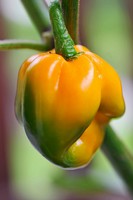 If you plan to dry them for chili powder or flakes, you can even leave them on the bush until they shrivel up and dry.
If you plan to dry them for chili powder or flakes, you can even leave them on the bush until they shrivel up and dry.
To harvest fresh chillies cut or pull off the mature fruit while it's still shiny and plump.
If you pull it off, pull it upwards, exactly opposite to the direction in which it bends down. Then it should snap off at the joint, without breaking off the whole branch. Otherwise just snip them off.
The fruit will last in a sealed bag in the fridge for up to a week.
You can dry it in the dryer or sun dry it, you could also just string it up and hang it up to dry in an airy spot.
Pound it to flakes or put it in the blender to make cayenne pepper and chili powder.
A word of warning
You don't need to eat chillies for them to burn you!
Just wait till you get Habanero chilli juice under your fingernails for the first time...
When cutting fresh chillies, make sure to scrub your hands well after. Don't touch your skin and especially don't touch your eyes! The hottest chillies can make you go blind. I am not kidding.
When working with dry chilli be VERY careful not to breathe in any powder. Also don't get it in your eyes.
Growing chillis in my permaculture garden
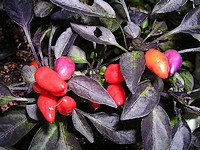 I mentioned at the top of the page that I went through a phase of chilli growing obsession where I grew a couple of dozen varieties. They are so ornamental!
I mentioned at the top of the page that I went through a phase of chilli growing obsession where I grew a couple of dozen varieties. They are so ornamental!
However, the most ornamental varieties seem to be less hardy. They seem to need better soil, more attention, don't live as long etc.
After the initial enthusiasm wore off, my innate laziness took over.
These days I have only three types of chillis growing in my garden: those that grow themselves. (Plus my beloved purple chili.)
Chillies self pollinate, but occasionally they also cross breed. If you save your own seed and grow more than one variety, then the offspring may grow just like the parent or it may be an interesting new combination.
All this to say, I am not sure what kind of variety my chillies are...
The toughest and most prolific, the one that anyone should be able to grow, is a huge bush of the Birds Eye type.
Those bushes grow to two metres in size and are always loaded with chillies.
The tiny fruit is blistering hot. The wild birds love them (did you know birds don't feel the heat in chillies?) and so do my chickens.
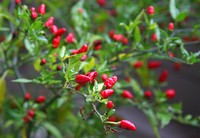 The seed spreads through the garden via birds and chickens, and I am forever pruning and chopping the bushes everywhere...
The seed spreads through the garden via birds and chickens, and I am forever pruning and chopping the bushes everywhere...
My favourite culinary variety is a type of Cayenne pepper, a medium sized bush with darker leaves and long skinny fruit of medium heat.
I always have a few bushes growing near the kitchen door, and I step out there on a daily basis to get some chillies. Some of the fruit doesn't get eaten and drops on the ground where the seeds eventually sprout. From there I transplant them when I feel energetic.
The third type of chilli I grow is a truly perennial type. I have a few bushes throughout the garden and they have been there forever. They bear fruit all year round, though not as much as my other two varieties.
The fruit is a bit shorter and wider than the Cayennes. It has no noticeable heat and I use it as a stand in for capsicum/bell peppers in cooking. (Not in salads, they are not as sweet or juicy or crisp as real sweet peppers, but for cooking they do the job.)
I dimly remember once, many years ago and living in a different place, I bought seed for a "Perennial Capsicum", a bell pepper that lives for many years and fruits all year round. I was a bit disappointed because it tasted nothing like the capsicums I knew. So maybe that's its offspring.
Anyway, I do grow all the chillies I need and then some, without ever having to buy seeds and without putting any work into it. Who cares what they are called!
Mirrored from http://www.tropicalpermaculture.com/
And here is some more information for people in cooler climates that need some extra tricks to overcome the lack of sunlight and temperature some of us more fortunate folk enjoy closer to the equator.
Sowing Seeds Early with Reflected Light

Jackie Brigden |
Friday, 10th January 2014
Want to start your seeds early but worried they won't have enough light? Jackie has a simple solution for all round light on the window sill.
Here's how I solve the problem of leaving baby peppers in the window sill propogator. Not an LED grow bulb in sight!

 Firstly use recycled card behind the propagator. This one is heated at the base.
Firstly use recycled card behind the propagator. This one is heated at the base.
 Cover it in kitchen foil to reflect the light.
Cover it in kitchen foil to reflect the light.
This means the seedlings do not grow forward towards the window but grow straighter, avoiding turning which makes plants grow leggy and weak.
Once under way, plants can also be moved from the toasty bottom heated south facing sill to the cooler west facing one, which should help to stop them over-growing too soon. The next stage (from propagator to greenhouse or polytunnel) is always the trickiest!
Read How to Grow and Look After Winter Herbs by Juliet Kemp
Glennie Kindred on Growing Salads in Winter
Watch Wade Muggletom's Practical Beginners Guide to Fruit Tree Pruning
Read Permaculture in Pots: How to Grow Food in Small Urban Spaces
Read Organic Gardening - The Natural No-Dig Way

 Firstly use recycled card behind the propagator. This one is heated at the base.
Firstly use recycled card behind the propagator. This one is heated at the base. Cover it in kitchen foil to reflect the light.
Cover it in kitchen foil to reflect the light. This means the seedlings do not grow forward towards the window but grow straighter, avoiding turning which makes plants grow leggy and weak.
Once under way, plants can also be moved from the toasty bottom heated south facing sill to the cooler west facing one, which should help to stop them over-growing too soon. The next stage (from propagator to greenhouse or polytunnel) is always the trickiest!
Further Resources
Read Heat a Greenhouse with Compost and Manure by Maddy HarlandRead How to Grow and Look After Winter Herbs by Juliet Kemp
Glennie Kindred on Growing Salads in Winter
Watch Wade Muggletom's Practical Beginners Guide to Fruit Tree Pruning
Read Permaculture in Pots: How to Grow Food in Small Urban Spaces
Read Organic Gardening - The Natural No-Dig Way
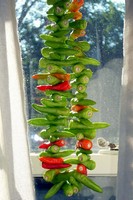
No comments:
Post a Comment